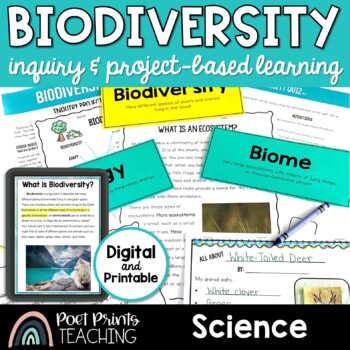Biodiversity Science Unit
- PDF
- Google Apps™

Also included in
- This is a BUNDLE of 5 hands-on science units that are perfect for Grade 3. All grade 3 science lessons are aligned to the British Columbia Grade 3 BC Big Ideas and NGSS. Each science unit includes detailed lesson plans so you don't have to create them! This bundle covers all of the Grade 3 BC BigPrice $34.99Original Price $48.00Save $13.01
Description
Biodiversity is all around is! In this hands-on complete biodiversity science unit students will explore local plants, animals, ecosystems, and food chains to discover the biodiversity in their area. Featuring directed lessons, project-based learning, and inquiry projects, a word wall, vocabulary, and complete assessments along the way.
Each lesson in this unit includes a complete teaching guide with detailed set-up instructions and thorough lesson plans. Take back your nights and weekends and let us do the planning for you!
What's included in this hands-on unit all about Biodiversity?
- Day-By-Day Teachers Guide - A daily lesson breakdown for using all parts of this biodiversity resource in sixteen 45-60 minute science lessons! The planning is all done for you. ✏️
- Introductory Worksheets - Introduce students your new unit to your students and remind them of what they know about biodiversity using the pages in this section of this packet. Choose the page(s) in this section that work best for your class. Have students brainstorm what they already know about the diversity of life around them and do some simple research to discover a little bit more. Try doing this part in pairs or small groups!
- Vocabulary - Vocabulary word wall cards using the major vocabulary from this Biodiversity unit. Vocabulary words in this unit include the terms: biodiversity, living, non-living, ecosystem, micro ecosystem, meso ecosystem, biome, energy, producer, consumer, decomposer, food chain, herbivore, carnivore, omnivore. This section also includes a vocabulary worksheet and a fun classroom activity.
- Nonfiction Reading - No Textbook? No Problem! This resource includes 4 informational reading passages at a third grade level. "What Is Biodiversity?" "What is An Ecosystem?" "Living and Non-Living Things" and "Life Needs Energy". All reading passages also come with accompanying reading response worksheets!
- Lesson: Living or Non Living - This lesson will focus on the different phases of the moon and will include an anchor chart, an engaging moon board, and a cut-and-paste activity.
- Lesson: Energy, Diets, and Food Chains - This lesson is broken into two parts. In part one, you will lead the students in an introductory activity where you read a non-fiction passage about eclipses and complete a Venn diagram together to compare the differences and similarities between solar and lunar eclipses. In part two, the students will create a comic to demonstrate the concept of either a lunar or solar eclipse in a fun way.
- Project: Biodiversity Around Us - In this project, students will look at the different forms of biodiversity all around them in this fun and creative mini-book project.
- Project: Local Animal Flip Book - Students will dive deeper into a local animal in this flip book project. PLEASE NOTE: This Animal Project can also be purchased separately HERE. Please check to see if you have already bought this resource.
- Inquiry - Living and Nonliving Biodiversity - In this inquiry-based learning activity students will participate in guided or open-ended inquiry projects that focus on how living and non-living things are intricately connected.
- Review Activities and Assessment - Use the ‘Mixed Up Puzzles’ activity to help students review for the Biodiversity Quiz. In this activity, students will match words to their definitions and corresponding pictures. When they are ready, use the quiz as a final assessment. It can also be used as a formative assessment to discover which areas to cover again.
Also includes 30+ digital Google Slides student pages ready for Google Classroom! These pages include:
- Introduction pages, non-fiction reading, reading comprehension worksheets, 'Biodiversity Around Me' digital student book, Digital Animal project research notes and flipbook, inquiry project planning pages
Aligned to the British Columbia, BC Big Ideas. Ontario Big Ideas, and NGSS
2-LS4-1
3-LS3-2
5-PS3-1
What are teachers saying about this Biodiversity Science Unit?
"My students loved this resource and so did I! The activities are engaging and this is still their favourite unit of the year. I will be using this for years to come." - Jessica H.
"This fits in great with the BC Grade 3 Science curriculum. My 3s are enjoying the activities and I like that there are reading passages with questions for them to answer. So far we are half way through the unit and everyone is excited when it is time for Science! Thanks!" - Denise M.
"My students loved this unit. Plus it was so easy for me to prep and use!" - Elisa C.





